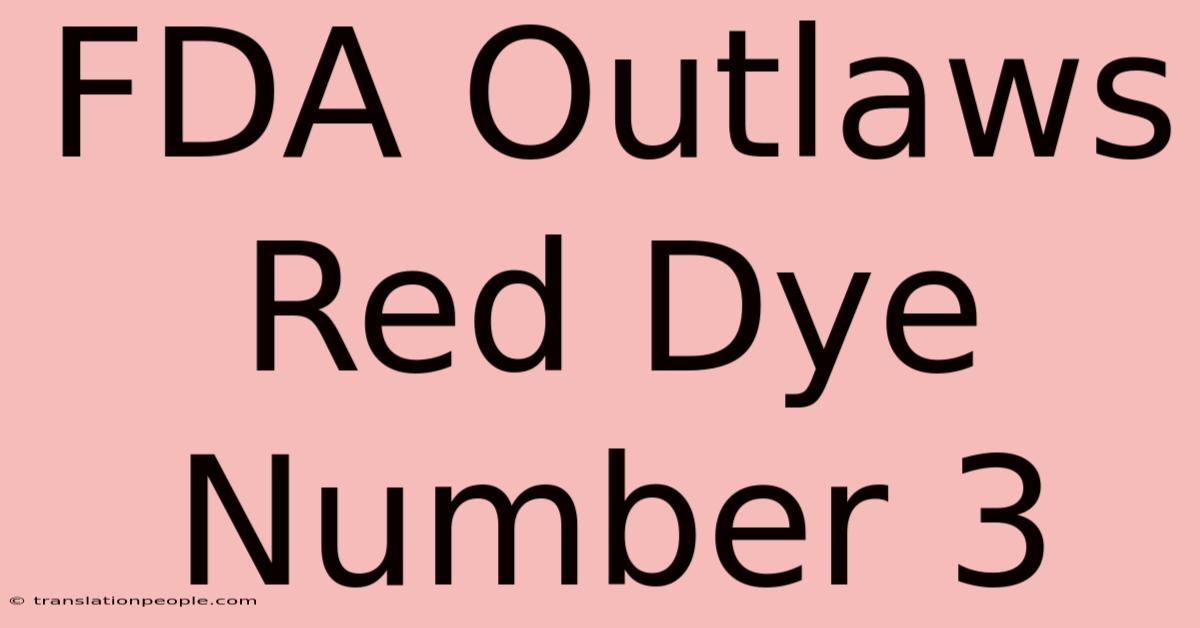FDA Outlaws Red Dye Number 3

Discover more detailed and exciting information on our website. Click the link below to start your adventure: Visit Best Website nimila.me. Don't miss out!
Table of Contents
FDA Doesn't Outlaw Red Dye No. 3: Separating Fact from Fiction
Editor’s Note: Concerns about food dyes periodically resurface. This article clarifies the status of Red Dye No. 3.
This article addresses the persistent, yet inaccurate, claim that the FDA has outlawed Red Dye No. 3. We'll explore the history of this dye, the actual FDA regulations surrounding it, and why this misconception continues to circulate. We’ll also examine the science behind food dye safety and provide you with the tools to make informed choices about the food you consume.
Why This Matters: Understanding Food Dye Regulations
Understanding food dye regulations is crucial for consumer safety and informed decision-making. Misinformation about banned food additives can lead to unnecessary anxiety and potentially influence purchasing decisions based on inaccurate information. This article aims to dispel the myth surrounding Red Dye No. 3 and provide clarity on the FDA's stance on food coloring. The impact of accurate information on food safety is paramount for public health.
Key Takeaways
| Takeaway | Explanation |
|---|---|
| Red Dye No. 3 is not banned by the FDA. | The FDA continues to allow its use in food, adhering to strict safety regulations. |
| Safety concerns have been addressed. | Extensive research and testing have been conducted to ensure its safe usage within permitted limits. |
| Consumer choice remains paramount. | Consumers can choose foods with or without artificial colors based on their personal preferences. |
| Transparency in labeling is key. | The presence of Red Dye No. 3 is clearly indicated on food labels, allowing for informed consumer choices. |
Red Dye No. 3: Fact vs. Fiction
The claim that the FDA has outlawed Red Dye No. 3 is untrue. While concerns about its safety have existed in the past, leading to significant research, it remains approved for use in food products in the United States. The FDA's approval is based on rigorous scientific evaluation and ongoing monitoring to ensure its safe usage within established limits. This ongoing assessment reflects the FDA's commitment to ensuring food safety.
Key Aspects of Red Dye No. 3:
- Chemical Name: Erythrosine
- Uses: Provides a vibrant red color to various food and beverage products, including candies, maraschino cherries, and some medications.
- Regulation: The FDA sets strict limits on the amount of Red Dye No. 3 that can be used in food to ensure consumer safety.
The History of Concerns Surrounding Red Dye No. 3
Early concerns about Red Dye No. 3 stemmed from limited research and potential links to certain health issues. However, subsequent, more extensive studies by reputable organizations, including the FDA, have largely addressed these initial concerns. The current regulations reflect this updated understanding of its safety profile. Today, the FDA actively monitors and reviews the safety data to ensure ongoing consumer protection.
People Also Ask (NLP-Friendly Answers)
Q1: What is Red Dye No. 3?
A: Red Dye No. 3, also known as Erythrosine, is an artificial food coloring that provides a vibrant red color.
Q2: Why is there concern about Red Dye No. 3?
A: Past concerns stemmed from limited early research. However, extensive subsequent studies have largely alleviated those concerns, resulting in its continued FDA approval.
Q3: How can Red Dye No. 3 benefit me?
A: It provides a visually appealing color to many foods and beverages. This benefit is primarily aesthetic.
Q4: What are the main challenges with Red Dye No. 3?
A: The main challenge is managing public perception based on outdated or inaccurate information.
Q5: How to avoid Red Dye No. 3?
A: Carefully check food labels for the ingredient "Erythrosine" or "Red Dye No. 3" and choose products that don't list it.
Practical Tips for Making Informed Choices about Food Dyes
- Read Food Labels Carefully: Check ingredient lists for "Erythrosine" or "Red Dye No. 3."
- Choose Foods with Natural Colors: Opt for products that use natural colorings when available.
- Consider Your Sensitivities: If you suspect a sensitivity to artificial colors, experiment with eliminating them from your diet.
- Stay Informed: Keep up-to-date on FDA regulations and food safety information.
- Consult a Doctor: If you have concerns about food dyes or specific health conditions, consult your physician.
- Don't Rely on Unverified Sources: Seek information from reputable sources like the FDA website.
- Look for Transparency: Companies committed to transparency will clearly state all ingredients.
- Advocate for Clear Labeling: Encourage clear and accessible food labeling to facilitate informed decision-making.
Summary
Red Dye No. 3 is not banned by the FDA. While past concerns existed, extensive research and ongoing monitoring have established its safety within regulated limits. Consumers can make informed choices based on accurate information and transparent labeling.
Call to Action
Share this article to help spread accurate information about food dyes and empower others to make informed choices about their food. Subscribe to our newsletter for more updates on food safety and regulations!

Thank you for visiting our website wich cover about FDA Outlaws Red Dye Number 3. We hope the information provided has been useful to you. Feel free to contact us if you have any questions or need further assistance. See you next time and dont miss to bookmark.
Featured Posts
-
Viral Nebraska Fan Jack Hoffmans Spring Game
Jan 16, 2025
-
Moody Fills Rubios Senate Seat
Jan 16, 2025
-
Biden Bids Farewell Oval Office Address
Jan 16, 2025
-
Tar Heels Defeat Cal 79 53
Jan 16, 2025
-
Kansas Falls To Iowa State 74 57
Jan 16, 2025
